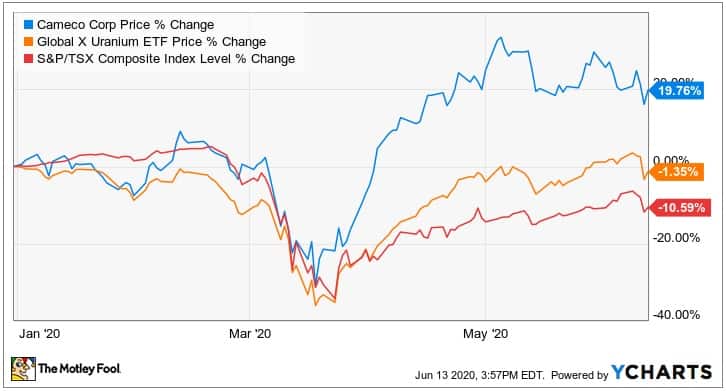Nuclear energy stocks have been hit hard by the surging unpopularity of nuclear power. The rapid growth of renewable sources of energy and power generation poses a direct threat to the survival of uranium miners. The 2011 Fukushima nuclear disaster triggered a price collapse for uranium and considerable negative sentiment regarding the outlook for nuclear power.
The catastrophe, which was the only nuclear incident to receive a level seven rating on the international nuclear and radiological event scale, caused uranium to enter a prolonged multi-year price slump. This had a disastrous impact on uranium miners such as Cameco (TSX:CCO)(NYSE:CCJ). Many have shuttered uneconomic operations to stem the flow of red ink.
Nonetheless, Cameco has gained 20% since the start of 2020 because of uranium soaring by 36%.

The latest rally appears overdone. The industry exchange-traded fund (ETF) the Global X Uranium ETF, in which Cameco is the single largest holding, failed to keep pace, losing 1%. There are substantial headwinds ahead for uranium, despite some analysts taking a bullish view regarding the outlook for the radioactive metal and nuclear energy stocks.
Why did uranium rally?
Uranium prices spiked not because of increased demand but rather due to the emergence of significant supply constraints. The coronavirus pandemic forced miners to shutter operations in accordance with government health guidelines aimed at preventing the spread of the virus.
Consequently, Cameco suspended production at its Cigar Lake uranium mine as well as operations at the Ontario-based Port Hope Conversion Facility’s UF6 plant and Blind River Refinery.
That caused global uranium supply, which has exceeded demand for some time, to fall below forecast consumption.
There are already moves afoot to reactivate operations at suspended facilities. Cameco recently announced that production at its suspended Ontario facilities will recommence. As the pandemic eases, uranium miners will move to restart shuttered assets. That will lift global supply over the short term, putting pressure on uranium prices.
Even the 55 reactors currently under construction, as estimated by the World Nuclear Association, will do little to significantly lift demand for uranium. On commissioning, many of those new facilities will only replace existing reactors that have reached the end of their operational life. This means that uranium demand won’t expand as significantly as expected.
Growing popularity of renewable energy
Over the long term, there are a wide range of headwinds. Key is the worldwide push to significantly bolster electricity production from renewable energy sources in place of nuclear power. The risks associated with the catastrophic failure of a renewable energy facility are far lower than those that arise if a nuclear reactor fails. This was clearly demonstrated by the Fukushima catastrophe.
Those hazards saw many countries, including France, Germany, Spain, Belgium, Switzerland, and South Korea, push to phase out nuclear power.
The aversion to nuclear power is aggravated by the falling cost of renewable electricity, which is substantially boosting the popularity of renewables. According to the U.S. Energy Information Administration, hydro, onshore wind, solar, and geothermal generate electricity more cheaply than nuclear power.
The cost and reliability of renewable energy will improve rapidly as technology advances. This will boost the rapid rate at which renewable technologies are already being adopted.
Poor outlook for uranium miners
That bodes poorly for Cameco and other uranium miners. Cameco is bleeding red ink and has been doing so for some time. The miner reported a net loss for four out of the last five quarters. The latest was a first-quarter 2020 $19 million loss.
Even Cameco’s savage cost cutting has done little to raise hopes of long-term profitability because of uranium’s poor outlook.
This means Cameco will eventually relinquish recent gains, which see it up by 20% for the year to date.
Foolish takeaway
The secular trend to renewable sources of energy combined with the considerable unpopularity of nuclear power bodes poorly for uranium and nuclear energy stocks over the long term. In fact, with the radioactive metal being squeezed at both ends of the demand and supply spectrum, it is difficult to see any sustained long-term rally occurring. That means there are further disappointing results ahead for Cameco. That makes the uranium miner a poor investment and stock to avoid.







